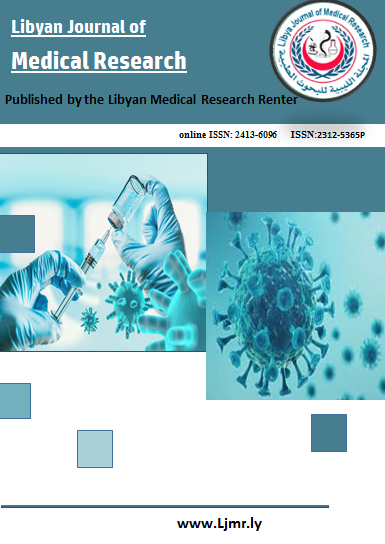Assessing Community Knowledge and Usage Patterns of Non-Steroidal Anti-Inflammatory Drugs (NSAIDs) in Zawia City: A Cross-Sectional Study.
DOI:
https://doi.org/10.54361/LJMR.191.1.27Keywords:
NSAIDs, knowledge, attitude, awareness,, side effects, overuse, safety perceptionsAbstract
Background: Non-steroidal anti-inflammatory drugs (NSAIDs) are among the most commonly used medications worldwide, known for their effectiveness in relieving pain and reducing inflammation. This study aims to assess the patterns of NSAID usage and the level of awareness regarding their benefits and potential side effects among the general public of Zawia city. Material and Methods: A cross-sectional survey was conducted over a period of three months from June 2024 through August 2024 in Zawia city, Libya, where a self-administered questionnaire was used. Descriptive statistics were used to analyze the data using the statistical package for the social sciences (SPSS V27). Result: The study involved 290 participants, mostly female (78.6%) and aged between 20-30 years (47.2%). A majority held a bachelor’s degree (61.4%) and were employed (58.6%). The primary reasons for NSAID use were headaches and colds (42.4%), followed by toothaches (35.5%). Most recommendations came from doctors (54.1%) and pharmacists (26.9%). 58.3% of respondents believed NSAIDs were not safe, and 67.6% thought they were overused. 52.8% were unaware of cardiovascular risks, and 59% were uncertain about the safety of NSAIDs during pregnancy. 83.8% believed that not all NSAIDs should be sold without a prescription. Conclusion: Despite high usage, most respondents perceive NSAIDs as potentially unsafe and overused, indicating a disconnect between awareness and behaviour.
Downloads
References
1. The rational use of drugs: Report of the Conference of Experts,[1] Nairobi, 25-29 November 1985. 2015. Available From: https://apps.who.int/iris/handle/10665/37174
2. Ghlichloo I, Gerriets V. Nonsteroidal Anti-Inflammatory Drugs (NSAIDs). In: StatPearls. StatPearls Publishing, Treasure Island (FL); 2023. PMID: 31613522.
3. Sostres C, Gargallo CJ, Arroyo MT, Lanas A. Adverse effects of non-steroidal anti-inflammatory drugs (NSAIDs, aspirin and coxibs) on upper gastrointestinal tract. Best Pract Res Clin Gastroenterol. 2010 Apr;24(2):121-32. [PubMed
4. Whelton A. Nephrotoxicity of nonsteroidal anti-inflammatory drugs: physiologic foundations and clinical implications. Am J Med. 1999 May 31;106(5B):13S-24S. [PubMed]
5. Kaufman DW, Kelly JP, Battista DR, Malone MK, Weinstein RB, Shiffman S. Exceeding the daily dosing limit of nonsteroidal anti-inflammatory drugs among ibuprofen users. *Pharmacoepidemiol Drug Saf*. 2018;27(3):322-31. Doi:10.1002/pds.4391. PMID: 29372579.
6. Hankar PR, Dubey AK, Dwivedi NR, Nandy A, Barton B.[9] Knowledge, perception and practice of self-medication among premedical and basic science undergraduate medical students. Asian J Med Sci 2016; 7(6): 63-8
7. Broniarczyk-Dyła G, Urysiak-Czubatka I. Cutaneous adverse effects of nonsteroidal anti-inflammatory drugs. *Post Dermatol Alergol*. 2007;XXIV(6):247.
8. Vonkeman HE, van de Laar MA. Nonsteroidal anti-inflammatory drugs: adverse effects and their prevention. *Semin Arthritis Rheum*. 2010;39(4):294. Doi:10.1016/j.semarthrit.2008.08.001.
9. Lanza FL, Chan FK, Quigley EM, Practice Parameters Committee of the American College of Gastroenterology. Guidelines for prevention of NSAID-related ulcer complications. Am J Gastroenterol 2009; 104: 728-38.
10. Whelton A. Nephrotoxicity of nonsteroidal anti-inf l ammatory drugs: physiologic foundations and clinical implications. Am J Med 1999; 106: 13-24.
11. Golar SK. Use and understanding of analgesics (painkillers) by Astonuniversity students. Biosci Horiz 2011; 4(1): 71-8.[http://dx.doi.org/10.1093/biohorizons/hzr009].
12. Kassie AD, Bifftu BB, Mekonnen HS. Self-medication practice and[20] associated factors among adult household members in Meket district, Northeast Ethiopia, 2017. BMC Pharmacol Toxicol 2018; 19(1): 15.[http://dx.doi.org/10.1186/s40360-018-0205-6].
13. Wawryk-Gawda, E., Chylinska-Wrzos, P., Lis-Sochocka, M., & Jodlowska-Jedrych, B. (2015). Consumption and awareness of students about nonsteroidal anti-inflammatory drugs. *Current Issues in Pharmacy and Medical Sciences, 27*(3), 175-178. https://doi.org/10.1515/cipms-2015-0010.
14. Atia A, Ashour A, Abired A. Survey on knowledge towards antibiotics among medical university students in Libya. Int J Medi Pharm Res 2018; 4(2): 61-6.
15. Bhattarai N, Basyal D, Bhattarai N. Self-medication practice among[16] undergraduate pharmacy students in Kathmandu Valley, Nepal. Int J Pharm Sci Res 2014; 5(11): 737-46.
16. Popa M. An examination of awareness of over-the-counter nonsteroidal anti-inflammatory drugs and adverse events. Walden University; 2014.
Downloads
Published
Issue
Section
License
Copyright (c) 2025 Mabrooukah ishrayhah, Hatim ishrayhah, Maha al-hadi Abd-alhafid, Noha al-Hadi Abd-alhafid (Author)

This work is licensed under a Creative Commons Attribution-NonCommercial-NoDerivatives 4.0 International License.
Open Access Policy
Libyan journal of medical Research (LJMR).is an open journal, therefore there are no fees required for downloading any publication from the journal website by authors, readers, and institution.
The journal applies the license of CC BY (a Creative Commons Attribution 4.0 International license). This license allows authors to keep ownership f the copyright of their papers. But this license permits any user to download , print out, extract, reuse, archive, and distribute the article, so long as appropriate credit is given to the authors and the source of the work.
The license ensures that the article will be available as widely as possible and that the article can be included in any scientific archive.
Editorial Policy
The publication of an article in a peer reviewed journal is an essential model for Libyan journal of medical Research (LJMR). It is necessary to agree upon standards of expected ethical behavior for all parties involved in the act of publishing: the author, the journal editorial, the peer reviewer and the publisher.
Any manuscript or substantial parts of it, submitted to the journal must not be under consideration by any other journal. In general, the manuscript should not have already been published in any journal or other citable form, although it may have been deposited on a preprint server. Authors are required to ensure that no material submitted as part of a manuscript infringes existing copyrights, or the rights of a third party.
Authorship Policy
The manuscript authorship should be limited to those who have made a significant contribution and intellectual input to the research submitted to the journal, including design, performance, interpretation of the reported study, and writing the manuscript. All those who have made significant contributions should be listed as co-authors.
Others who have participated in certain substantive aspects of the manuscript but without intellectual input should only be recognized in the acknowledgements section of the manuscript. Also, one of the authors should be selected as the corresponding author to communicate with the journal and approve the final version of the manuscript for publication in the LJMR.
Peer-review Policy
- All the manuscripts submitted to LJMR will be subjected to the double-blinded peer-review process;
- The manuscript will be reviewed by two suitable experts in the respective subject area.
- Reports of all the reviewers will be considered while deciding on acceptance/revision or rejection of a manuscript.
- Editor-In-Chief will make the final decision, based on the reviewer’s comments.
- Editor-In-Chief can ask one or more advisory board members for their suggestions upon a manuscript, before making the final decision.
- Associate editor and review editors provide administrative support to maintain the integrity of the peer-review process.
- In case, authors challenge the editor’s negative decision with suitable arguments, the manuscript can be sent to one more reviewer and the final decision will be made based upon his recommendations.














